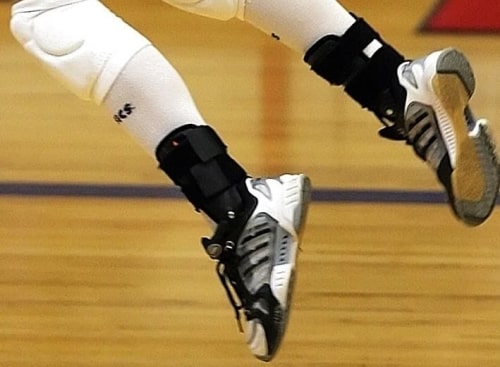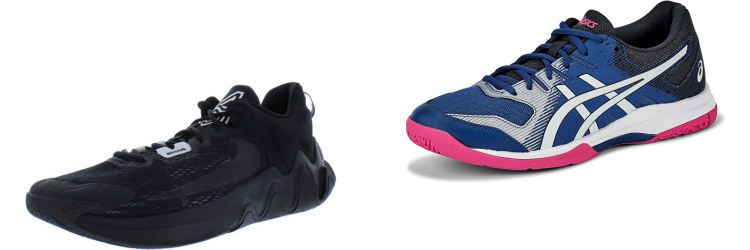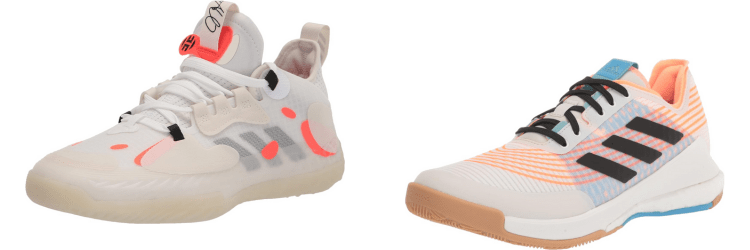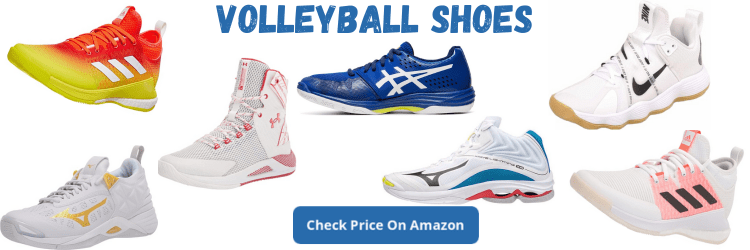Are Volleyball and Basketball Shoes the Same

In the dynamic world of athletic footwear, the intersection of performance and style is a realm that captures the attention of sports enthusiasts and athletes alike. Among the myriad questions that arise, a prominent one revolves around the interchangeability of volleyball and basketball shoes.
This article undertakes a comprehensive exploration of the similarities and differences between these two specialized categories of sports shoes, unraveling the intricacies that make them distinct and essential for optimal performance in their respective sports.
Similarities
So, are volleyball and basketball shoes the same? At first glance, volleyball and basketball may seem worlds apart, but a closer examination reveals striking similarities in the demands placed on the athletes and the corresponding design features required in their footwear.
Dynamic Movements: Both sports involve rapid and dynamic movements. Whether it’s a basketball player swiftly maneuvering through defenders or a volleyball player leaping for a powerful spike, the shoes must provide the necessary support and responsiveness for quick changes in direction.
Jumping and Agility: The act of jumping is a fundamental aspect of both volleyball and basketball. Athletes in these sports rely on explosive jumps to score points, block shots or secure rebounds. The shoes must facilitate these jumps while ensuring a balance between elevation and stability.
Traction and Lateral Support: The need for solid traction during lateral movements is a common denominator. In both volleyball and basketball, athletes perform quick side to side movements, requiring shoes with excellent grip to prevent slippage and enhance stability.
Brand Diversity: Recognizing the shared needs of athletes in these sports, renowned sports footwear brands such as ASICS, Nike, Mizuno and Adidas offer specialized shoe lines catering to both volleyball and basketball. This acknowledgment underscores the universality of certain design elements essential for performance in these sports.

Differences
While the similarities lay a foundation, the nuanced differences between volleyball and basketball shoes become apparent when scrutinizing specific design elements tailored to the unique demands of each sport.
Cushioning: One of the key differentiators is the approach to cushioning. Volleyball shoes prioritize responsive cushioning to facilitate quick jumps and landings. The emphasis here is on energy return and agility. In contrast, basketball shoes give precedence to impact absorption, considering the high jumps and repeated forceful landings inherent in the game. The focus is on providing a level of cushioning that minimizes the impact on joints and muscles.
Midsole Height: The midsole height is another distinguishing factor. Volleyball shoes tend to have a lower profile, emphasizing a connection to the court for enhanced feel and stability. The lower midsole allows players to respond quickly to the ever changing dynamics of the game. On the contrary, basketball shoes often feature a higher midsole, extending beyond the ankle to provide crucial support. This design is intended to safeguard against ankle injuries during abrupt movements and landings.
Material Composition: The materials used in the construction of these shoes also vary to meet the specific needs of each sport. Volleyball shoes often employ lightweight materials such as mesh to enhance flexibility and breathability. The focus is on ensuring the footwear doesn’t impede the natural movements of the foot.
In contrast, basketball shoes may incorporate thicker leathers and synthetic materials to provide increased durability. This design choice reflects the physicality of basketball, where players often engage in more direct contact with opponents.
Outsole Patterns: The outsole, a critical component influencing traction, showcases notable differences. Volleyball shoes typically feature herringbone patterns on the outsole, designed to maximize grip on the smooth surface of the court. This pattern excels in providing stability during lateral movements.
Conversely, basketball shoes integrate multi-directional patterns into their outsoles. This design accommodates the quick changes of direction inherent in basketball, allowing players to make sharp cuts and navigate the court with agility.

Brand Spotlight
An in depth analysis of prominent sports footwear brands provides valuable insights into how they navigate the nuances of designing shoes for both volleyball and basketball athletes.
ASICS: A stalwart in the athletic footwear industry, ASICS caters to the distinct needs of volleyball and basketball players with dedicated product lines. The Gel-Rocket, a popular choice among volleyball enthusiasts, emphasizes stability and responsiveness, crucial for the agility required in the game.
On the basketball front, the Gel-Kayano series showcases advanced cushioning technologies tailored to absorb the impact of high jumps, reflecting ASICS‘ commitment to addressing the unique demands of each sport.
Nike: As a global leader in sports apparel, Nike adopts a multifaceted approach in designing shoes for both volleyball and basketball. The Hyperfuse Volley series is crafted to meet the specific needs of volleyball players, offering lightweight support and breathability.
On the basketball side, the Hyperdunk series stands out with its innovative technologies geared towards enhancing performance during the high intensity nature of the game. Nike’s commitment to pushing the boundaries of athletic footwear is evident in the tailored features of each line, recognizing the nuances of volleyball and basketball.
Mizuno: Mizuno, with a distinct focus on volleyball, manifests its dedication through specialized shoe lines that prioritize superior cushioning and support. The Wave Horizon series, designed for volleyball enthusiasts, exemplifies Mizuno’s commitment to providing footwear that enhances performance on the court.
In contrast, their basketball line, exemplified by the Wave Creation series, incorporates features unique to the demands of basketball. This approach showcases Mizuno’s nuanced understanding of the distinct requirements in both sports.
Adidas: Renowned for its innovative technologies, Adidas brings a unified approach to volleyball and basketball footwear. The Boost cushioning technology, a hallmark of Adidas innovation, finds its way into both Crazyflight (volleyball) and Harden (basketball) lines.
This exemplifies Adidas’ commitment to providing responsive cushioning across different court sports while adapting the technology to cater to the specific needs of each sport. The brand’s versatility and dedication to performance are evident in their thoughtful integration of technologies into volleyball and basketball shoes.
Conclusion
In conclusion, the question of whether volleyball and basketball shoes are the same unfolds into a nuanced exploration of the intricate details that define each category. While commonalities exist, the differences are substantial and underscore the importance of specialized footwear in the realm of sports.
Choosing the right pair of shoes is not merely a matter of style; it is a strategic decision that significantly impacts an athlete’s performance and well being on the court. The importance of responsive cushioning in volleyball shoes versus impact absorption in basketball shoes, the midsole height for court feel versus ankle support and the variation in material composition and outsole patterns. All these factors culminate in distinct design philosophies.
What The Pros Say
Athlete Quotes: To provide a human perspective on the significance of choosing the right shoes, let’s turn to the words of renowned athletes.
Basketball legend Michael Jordan once said, “I’ve missed more than 9,000 shots in my career. I’ve lost almost 300 games. 26 times, I’ve been trusted to take the game winning shot and missed. I’ve failed over and over and over again in my life. And that is why I succeed.” Jordan’s words encapsulate the essence of resilience and the iterative process of improvement, highlighting the role of footwear in an athlete’s journey.
Volleyball player testimonials also shed light on the impact of choosing the right shoes. One player shared, “Switching to shoes with better traction transformed my game. I could make sharper cuts and dive for balls without worrying about slipping.” These personal experiences underline the tangible difference that appropriate footwear can make in an athlete’s performance.
In Closing
Transitioning between volleyball and basketball shoes reveal the subtleties that have significant influence of comfort and performance on the court. The lower profile of volleyball shoes provide a heightened sense of connection to the court, enhancing responsiveness during rapid movements. Conversely, the higher midsole of basketball shoes offer a reassuring stability, particularly during abrupt stops and jumps.
Considering the diversity of experiences, it becomes evident that the right pair of shoes impacts not only performance but also the overall enjoyment of the sport.
Comparative Table:
| Feature | Volleyball Shoes | Basketball Shoes |
|---|---|---|
| Cushioning | Responsive for quick jumps | Impact absorption for high jumps |
| Midsole Height | Lower for court feel and stability | Higher for ankle support |
| Material | Lightweight, breathable (e.g., mesh) | Durable (e.g., thicker leathers) |
| Outsole Pattern | Herringbone for court grip | Multi directional for quick changes |
This table distills the key features, providing a quick reference for athletes seeking to make an informed decision based on their specific needs and playing style.
In conclusion, while the worlds of volleyball and basketball may share some common ground, the intricacies of their respective demands necessitate specialized footwear. The exploration of design philosophies from leading brands, athlete perspectives, personal anecdotes and a detailed comparative table collectively underscore the importance of choosing the right shoes tailored to the unique dynamics of each sport.
As athletes embark on their journey to excellence, the quest for the perfect pair of shoes becomes an integral part of the pursuit of mastery on the court.


